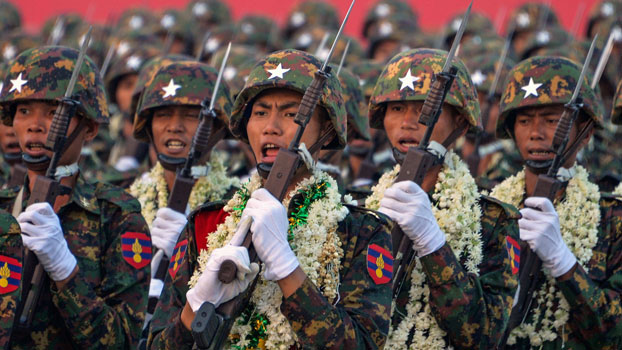Much has been said of the brutal military Myanmar coup but one question remains inadequately addressed. Why is Myanmar so prone to military coups? Indeed, for most of the country’s postcolonial years since independence in 1948, it been under military rule. Beyond the popular explanation of power hunger of military leaders, could it also be a false sense of a patriotic role of the military as guardians of the political establishment – an inherited DNA from the military’s roots as freedom fighting activists. Can an army with such a history be purely be professional fighters driven by the motto: “Theirs not to reason why, Theirs but to do and die”. A hypothetical scenario should illustrate this point. If in 1947 it was the Indian National Army, INA, which liberated India, would the Indian Army with the INA’s genes in it, have been the same?
Field Marshal, Viscount William Slim’s war diary which became an important book on WWII history in the Burma theatre, “Defeat Into Victory”, has some interesting clues buried deep inside its 540 pages, describing how he twice met General Aung San, father of Aung San Suu Kyi, and leader of Myanmar freedom struggle as well as founder of a militiamen army, which first called itself Burma Defence Army and later Burma National Army, to negotiate terms for the latter switching sides to the British after some years of fighting alongside the Japanese and the INA. This was in May 1945 after Slim managed to turn the table against what had seemed like an unstoppable push towards India by the Japanese, and the Japanese were then the losing side. Whether this was opportunism or Aung San developed irreconcilable differences with the Japanese, is another question. Slim took the step after much discussions on the British side, with many of the opinion that militarily this would be pointless and that the group’s Burmese nationalism would be a headache for the British after the war. Allied Supreme Commander in the Pacific Theatre, Lord Mountbatten however favoured Slim’s proposal, therefore the meeting.
Slim met Aung San, both at the British HQ at Meiktila. In the first on May 15, Slim said he was impressed by Aung San’s commitment, honesty and intelligence, but also realised how broken the BNA was at the time. He also learnt from Aung San that the resistance movement was headed by a provisional government formed by his Anti-Fascist People’s Freedom League, AFPFL. Aung San in the initial meeting wanted this provisional government be taken in as an ally, with himself as an Allied Commander. Slim refused and made it clear that if the BNA wanted to side with the British, it will have to come under British command and that BNA will not be taken in as a separate unit, absorbed into the Burma Rifles of the British. In the second and final meeting on May 30, Aung San conceded to Slim’s terms but insisted on two of his important conditions – his troops be paid and rationed by the British, and that if major orders were to be given to the BNA soldiers, the resistance leaders be consulted. Slim agreed to these.
At the time of Burmese independence in 1948, it was Aung San’s provisional government which inherited the British administration. Quite understandably, such a government would carry plenty the DNA of its past avatar as a resistance movement under the AFPFL with no clear separation between the military and political responsibility. Writer and Burma watcher, Bertil Lintner also has observed in an article that the Myanmar army presumes “the dwifungsi, or dual function, doctrine of the Indonesian army that stated that the military has both a defence and social-political role”. This transition of power in Burma to the AFPFL also somewhat alienated the ethnic minorities, whose loyalty to the British while they were rulers, were much longer and steadfast. From this vantage, Myanmar’s current problem can be seen as a consequence of the nation’s inability to: first, purge its defence forces of the political DNA inherited from the days they were freedom fighters. Second, is the inability to work out a comprehensive federal political structure to satisfactorily and equitably share power between its many nationalities.
Even after (or if) the current crisis in Myanmar is resolved, it is quite obvious the country will need to exorcise its military of its political genes as much as to work out a comprehensive federal political structure. If not, it is likely even if democracy returns, the spectre of a military coup can materialise anytime in its future again. It may be of interest to note here that there are other nations which won militia-led freedom, and have had to tackle similar challenges. Indeed, the contentious 2nd Amendment of the US may be the country’s own way of sublimating, or inability to do so completely, a similar issue.
(This article was first published in The Telegraph, Kolkata and can be read here https://www.telegraphindia.com/opinion/myanmar-the-tatmadaws-political-genes/cid/1816616)












